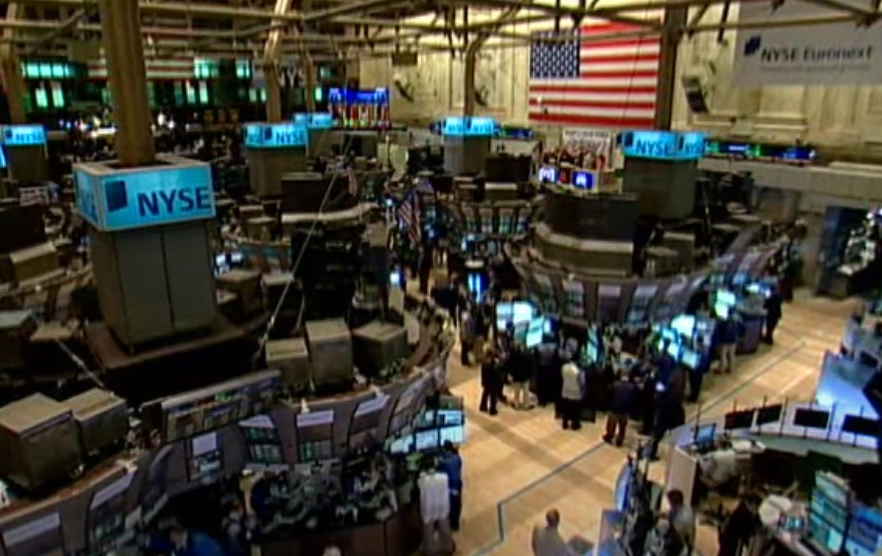Are you losing money day trading stocks? You may have heard the numbers that 95% of traders lost money or that just a couple of percent of traders earn a living at it. The simple fact is many traders will lose money day trading stocks and it can not be easily prevented. All kinds of reasons are given for your losses, such as bad luck, poor cash management, poor time, or a bad plan. The fact is, however, while you may make money in the short term, over the long-term you are more likely to lose trying to day trade, and should therefore most likely stick to longer-term investment strategies.
Stock Price Movement
To comprehend why many who trade stocks lose, we will need to understand how stock prices move and what causes them to move. In addition, we should take into account the high amount of folks who get involved directly as soon as the price is going to change. This is the place where the bulk of losses occur.

If a purchasing frenzy takes hold in a current market, it is difficult to observe the motion for what it is: something which will end. But at the present time, people view other folks purchasing, making them believe they should they purchase today then other people would purchase after them. Anytime you create a speculative buy, you’re doing this because you think other people would purchase after you, pushing up the price which permits you to sell for a gain.
Stock prices increase if more folks are stepping into purchase than are eager to sell. While we could do all kinds of fancy analysis and also create predictions, all we’re really doing is creating a wager that individuals will step in to purchase or sell. We’re analyzing individuals, since it’s individuals who purchase and market and cause stock price to proceed. And it is those who create repeating patterns, which we are able to trade from, in the financial markets.
Buying at the top
An uptrend is made by an increasing number of people continued to push the stock up. Folks will need to be ready to pay higher and higher prices. Finally, there are not any more individuals that are eager to purchase at higher prices, or you will find more people eager to sell than buy. The men and women who bought close to the top are left handed the losses.
One large issue is that a very high amount of individuals become involved directly close to the top. After the masses have piled there’s absolutely no one else to purchase and the men and women who bought previously in the tendency begin to market, which scares the men and women who purchased late in to sell, and the domino effect starts bringing down prices.
Let us look for instance: GameStop (GME) in 2021. Towards the beginning of 2021, a great deal more people became curious with the news on GameStop and the message boards. With all the news on GameStop there was a explosion, and a hope of quick wealth, bringing a completely new batch of buyers to the stocks. While early on, GameStop made possible sense as an investment due to potential positive catalysts. However, later these catalysts were already priced into the stock and that’s when the masses began to jump in and many sustained large losses. Early investors were rewarded while late ones suffered losses.
Definitely, involvement was the greatest near the very top. While informed investors made money off this buying frenzy, the people who made the purchasing frenzy (and also the information shows they purchased in the top), dropped a great deal of cash.
 The majority of men and women become concerned near turning points. Which means most men and women shed, and therefore are from the simple fact that the catalyst for turning the marketplace another way. There’s a limit to all, and also the mass frenzy triggers that limitation to be struck.
The majority of men and women become concerned near turning points. Which means most men and women shed, and therefore are from the simple fact that the catalyst for turning the marketplace another way. There’s a limit to all, and also the mass frenzy triggers that limitation to be struck.
However, the marketplace keeps slumping greater and a number of those stragglers combine in and purchase. Some still hold out as well as the marketplace keeps ticking greater. Finally, most of the populace is bullish, and there are still a few stragglers, along with the market keeps moving up. At length, pretty much each man who may possibly buy is currently in, and marketplace plunges the other way.
When fund managers have practically no money available it means they’re fully invested on the sector which means a change is very likely to happen shortly. The dilemma is that the marketplace doesn’t generally reverse reduced before the funds/investors are in, and it does not move considerably higher until cash was pulled from the sector and many funds/investors are holding a lot of money to reinvest.
The marketplace is not likely to reverse to some substantial degree until nearly everyone is on both sides. Which means nearly everyone who joined the party late will lose. A whole lot of people might just opt to wait but will the marketplace. And when people are split, then the marketplace will proceed into a such fashion. Without a high number of individuals to make an intense, the marketplace will not hit an intense and reverse.
Not only are many people left holding the bag on top, they also often scared out of the market at market bottoms. Their capitulation selling signifies there’s not any one left to market, so shortly after the purchase price starts climbing. Once the prognosis is the most gloomy, since everybody you know is losing money and everything you see on TV is how poor the markets really are, there’s strong incentive to market and follow the audience. Yet more, the audience makes a bad choice, which it can not help doing, and also the market turns another way.
The examples are only supposed to demonstrate that the majority of individuals shed by behaving in mass in precisely the exact same moment. The masses can not avoid it, since it’s there actions that exhausts the tendency and drawbacks it. Although a long-term graph of the market indicates the purchase price of stocks climbing, keep in mind that the majority of the individuals are flushed out since they’re purchasing near selling and peaks close slopes. Moreover, those long-term graphs of the stock exchange, such as the S&P 500 indicator, do not incorporate the stocks which have gone bankrupt or even fallen on tough times. The S&P 500 just includes top businesses. If a business starts losing money, it’s dropped from the catalog and consequently has no negative impact on it.
Following the Crowd
That is where ineffective traders fail and the audience loses money. After you hear from the friends and the networking is how great that this advantage is performing, or how awful that advantage is performing, it is difficult to have a contrarian perspective. As people, we have a tendency to default to accessibility prejudice, which is presuming that which we hear frequently. Should you make a wager against everybody else and you’re incorrect, your buddies laugh at you or you’re feeling sheepish. You experience sorrow for missing while some gain.
There’s a social cost not to be a part of the audience. You can not speak about transactions with other people, or you have to tread carefully since the majority of folks won’t hold your opinion. Should you have an opposite view into the audience, and you’re right, people can despise you because you made cash while they lost their top. Sound absurd?
It’s extremely simple to think you can get out ahead of the crowd. Following through on this is rather difficult. that is the reason why audiences move collectively. Everybody in the audience thinks that. Furthermore, if you know bid and ask prices, once people begin to market there are just so many stocks are every cost level, and thus in the event that you would like to get out you want to market to a lower bid price, then a lesser price, then a lesser one. Everyone can not get out, just the fastest and most seasoned commonly get out before real harm is done.
Nonetheless, it isn’t the professional cash manager demonstrating their ignorance, it’s those critics who know nothing about market moves. Most marketplace movement is made by professional money managers that are handling trillions of dollars in resources, and by additional professionals/businesses. Many of those fund managers will under-perform. Nearly all traders and investors won’t beat the grade because they create and are part of the benchmark.
What’s really intriguing is that while a fantastic hedge fund may create a mean of 20% year during the previous twenty decades, the typical investor in that finance has a higher likelihood of earning less than that. Why? Since they spend and pull out their capital at the wrong time. Particular traders do be able to outperform consistently. A number of different dealers and novice traders return to the markets using a small number of bills and lose it. There’s a steady and constant stream of those folks. They nourish the kitties of these traders who are successful. Additionally, the fact that all these men and women pile into (from ) market tops (bottoms) means you will find positive opportunities for the ones that may maintain an objective eye on the marketplace.
For a person to win, somebody else has to lose or give up gain.
The huge returns which lure folks in droves into the markets are what generate huge returns for losses and others into the droves. Crowds can not create powerful tendencies until all are involved. A tendency will not stop until almost everyone is on board with the audience. Considering that the audience can not triumph, that means just a small fraction of people can.
Day traders get trapped in precisely the exact same audience behavior without understanding it. That increasing stock they see all morning before leaping in, just to get it move another way, is precisely the exact same happening on a smaller scale. They experience brief long bursts of emotion that lead to short and long term actions/reactions, all resulting in patterns that are observable on all time frames. You will find are also levels of bullishness and bearishness over time frames, meaning times the trends and reversals are going to be competitive and sometimes more sedate based on the number of dealers (and the people ) are included.
The most important thing is that traders should stick to some well-defined strategy and trade that strategy even if it’s uncomfortable. Because the majority of the populace is more than pleased to combine with the audience, by having subject together with an adequate strategy it’s likely to be among the few successful dealers that does not participate in the audience’s losing ways.
Think Independently to be successful
For people who actively wish to trade, do not be tempted into the general audience. Think independently, so doing your research. Have a look at charts and see how costs responded to unique occasions and cost patterns. Develop or find out strategies for benefiting from shared price patterns. You do not have to be correct all of the time, even if a pattern just works out 50 percent of this time, however if you earn more on winners than you shed on winners, that’s a winning blueprint. In producing your own trades according to your research and strategies you’ll at times be aligned with all the audience, and at times you won’t. However, it does not matter. You are trading your game, according to data you understand and trust from performing your study and analyzing your strategy.
When you’ve got a technique, switch off the TV, discussion boards, along with other’s views of this marketplace. You’ve completed the job on your strategies, so expect them. Everybody comes to trading stating they will be better than everybody else, or that they simply need a small taste of their profits and they’ll be happy. However, to earn money consistently means that you have to be at the top few percentage on the planet. Being at the top few percent of whatever is not simple. However, it can really be as straightforward as purchasing and holding an index fund to get a slow accumulation of earnings. That’ll place you ahead of a good deal of hedge fund shareholders. Or, if you would like higher yields that are certainly possible, it entails learning or developing plans and then placing them into training more actively
We’re just as great as our subject. We could be a fantastic trader daily, and stink bad another if we stop following our strategy. A lot of men and women feel that once they get profitable they could unwind. Can you see professional athletes simplicity away after they make it into the pros?
Those that survive like it. They like the challenge and the contest. People who adore trading will place in hours without day considering it. Individuals who just trade to earn a fast buck won’t ever have the ability to compete with the individual who enjoys it and immerses himself in the practice of studying and improving. Only trade in the event that you truly wish to. With no fire you’re at a massive disadvantage to the men and women who possess it.
While I think that it’s very important to clarify things people know what they’re getting into. You need a great deal of time to become successful at trading, and put in a great deal of time to keep that performance and attempt to improve. Though some with commitment, time, and enough funds can be successful in trading, the majority of folks will lose. As people we have an option regarding how much effort we will put into it.



 The majority of men and women become concerned near turning points. Which means most men and women shed, and therefore are from the simple fact that the catalyst for turning the marketplace another way. There’s a limit to all, and also the mass frenzy triggers that limitation to be struck.
The majority of men and women become concerned near turning points. Which means most men and women shed, and therefore are from the simple fact that the catalyst for turning the marketplace another way. There’s a limit to all, and also the mass frenzy triggers that limitation to be struck.

 First, you need to gather information. If the task was assigned to you, find out from your manager what she wants to accomplish with this training. What should the students know at the end of the class? If you were going to issue a certificate, what would it certify your class members to do? If you are the manager, sit down and think through what you want to accomplish with this training. Set goals. And develop an evaluation sheet for students to complete when they are finished with the course work. Ask questions that will give you feedback about whether you met your goals. Did they learn what you wanted them to learn? Did they find the course interesting? What would they want to see improved? What did they like the best?
First, you need to gather information. If the task was assigned to you, find out from your manager what she wants to accomplish with this training. What should the students know at the end of the class? If you were going to issue a certificate, what would it certify your class members to do? If you are the manager, sit down and think through what you want to accomplish with this training. Set goals. And develop an evaluation sheet for students to complete when they are finished with the course work. Ask questions that will give you feedback about whether you met your goals. Did they learn what you wanted them to learn? Did they find the course interesting? What would they want to see improved? What did they like the best?